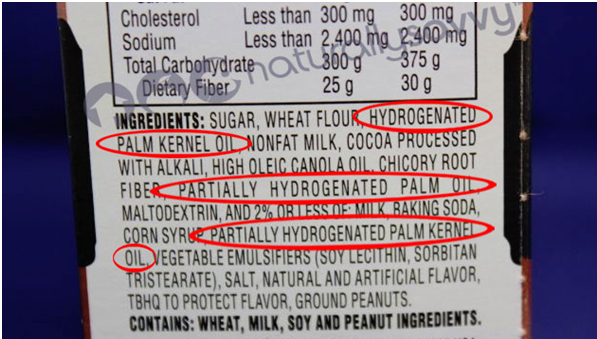Palm Oil: What, Where, Why?
As you walk through a grocery store with your family, do you ever wonder what all the delicious snacks are made of? Next time you ask mom to buy you a KitKat bar, take a look at the back of the package. See what it’s made of. You may be surprised to find that many of the things you eat or use every day contain palm oil.

Label with palm oil listed as ingredient.
Where does palm oil come from?
Palm oil comes from a tree called the oil palm tree. This tree grows in humid climates. Rainforests are hot, humid and get a lot of rain. Rainforests have the perfect conditions for growing oil palm trees.
The trees grow a large red fruit called “red palm oil” or “oil palm fruit”. It can be made into a lot of oil. This oil is used in many different things; some you can eat, some you clean with, some you wear as make up, and more.

Oil palm fresh fruit bunch.

An oil palm fruit.
Beyond having many uses, one oil palm tree can produce a large amount of oil. The oil palm tree is among the plants that make the most oil humans can use. One acre of land (which is almost the size of a football field) planted with palm oil trees can produce almost 7 tons of oil. That’s enough to fill over 5,000 water bottles with palm oil!

Oil palm fruit cut in half.

Close up on an oil palm fruit cut in half.
Lots of oil comes from each tree. Being able to make a lot of oil from one tree means that anyone planting these trees can sell a large amount of oil from just a few trees.
Why use palm oil?
More and more every day palm oil is being used to make common things you find in your house. It is often used in food because it holds together well. For example, it keeps chocolate from melting at regular room temperature. The same goes for some margarines and cookies.

Frequently it is used to make soaps. Palm oil can be broken down to make dish-washing soap, shampoos, makeup and toothpaste.
Palm oil can even be used in biofuels to run cars or buses.
Using plant oils is more popular than using animal fats. Researchers say one big reason this is happening is people want to eat healthier things. Before, it was common to find animal fat such as butter or lard in things you ate every day. Animal fat is less healthy than many vegetable oils and sometimes animals must be killed to make it. Now, more people want vegetable oil instead of animal fat. So more people want a product like palm oil.
Why care?
While it seems like using palm oil in everyday products is a good thing, the large amount humans use is having an impact on the places where palm oil is grown. Palm oil plantations, the places where palm oil is grown, are sometimes fields that were already used to make food. But often rainforests are cleared to create more palm oil plantations.

This used to be a rainforest. Now it is bare ground.
The picture below is a rainforest.

Deforestation for oil palm. The rainforest has been cut down and will be replaced by oil palm trees.
Soon it will be a palm oil plantation. Nothing else will grow on this land when it is a palm oil plantation.
What do you think happened to the animals that used to live in the forest?
What do you think happened to the plants that used to grow in the forest?
Adapted from the following articles:
- Rhett A. Butler. Why is Palm Oil Bad for Orangutans? June 24, 2004.
- Pek Shibao. Why Palm Oil Expanded, and What Keeps it Growing? March 26, 2015.

